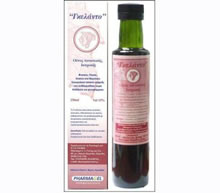
Λεξικό .. Apricot [(L) Prunus armeniaca]
Apricot, almond, cherries and peaches belong to the same family Prunoideae and are known to induce symptoms when eaten by some birch pollen allergic individuals. This crossreactivity could be explained from the antigenic patterns of timothy grass, peach, apricot, plum and cherry,which are similar as seen in SDS-PAGE. Pastorello et al (2000) identified in a study the major allergen from apricot in a population of 30 patients with oral allergy syndrome (OAS), and showed it was a lipid transfer protein (LTP) with 95% sequence homology with peach. Besides this allergenic LTP, they found another LTP in apricot, similar to the first but not capable of binding IgE antibodies from allergic subjects, which was homologous with the Arabidopsis thaliana LTP:
the role of this protein is still not clear [1]. Pastorello et al, (2001) also identified an LTP acting as a major allergen in plum, Pru d 3, which shows more than 90% sequence homology with LTPs from peach and apricot[2]. The high homology between these proteins accounts for the frequent clinical cross-reactivity between Prunoideae fruits observed in patients' histories. See Prunoideae[3, 4].
1.Conti A, Fortunato D, Ortolani C, et al. Determination of the primary structure of two lipid transfer protein from apricot (Prunus armeniaca) J Crom B 2001;756:123-129.
2.Pastorello EA, Farioli L, Pravettoni V, et al. Characterization of the major allergen of plum as a lipid transfer protein. J Chrom B 2001;756:95-103.
3.Pastorello EA, Purello D'Ambrosio F, Pravettoni V, et al. Evidence for a lipid transfer protein as the major allergen of apricot. J Allergy Clin Immunol 2000;105:371-377
4.Pravettoni V. Et al: Evaluation of crossreactivity between Prunoideae and timothy by SDS-PAGE. Schweiz med Wschr. 1991:121(Supl 40/11):80/p2291.
Γκέλης Ν.Δ. - Λεξικό Αλλεργίας - Εκδόσεις ΒΕΛΛΕΡOΦΟΝΤΗΣ - Κόρινθος 2013
Gelis Ν.D. - Dictionary of Allergies - VELLEROFONTIS Publications - Corinth 2013




